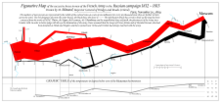
Attrition warfare represents an attempt to grind down an opponent's ability to make war by destroying their military resources by any means possible, including scorched earth, people's war, guerrilla warfare and all kind of battles apart from a decisive battle.[1] Elements of this kind of warfare had already been used in the Peninsular war. The Russian attrition warfare against Napoleon began on 24 June 1812 when Napoleon's Grande Armée crossed the Neman River into Russia and ended on 14 December 1812 with the total defeat of the Grande Armée. A visual representation is given by the drawing of Charles Joseph Minard. The Trachenberg Plan was used in the Sixth Coalition in Germany 1813 and in France 1814. The Seventh Coalition defeated him at Waterloo in 1815 and exiled him to Saint Helena, where he died six years later.
- ^ idlocgov 2022, Sources.
